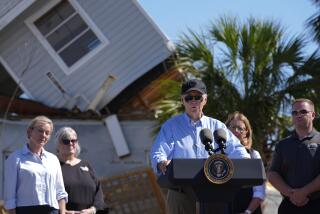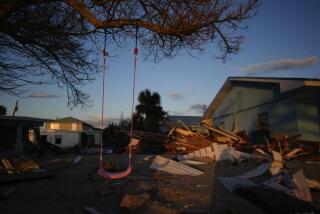Evacuees Return as Punch of Hurricane Georges Fades
PASCAGOULA, Miss. — The whirlwind that had been Hurricane Georges began to disappear from the weather map Tuesday, but its story was still being written: Rains drenched Alabama and the Florida Panhandle, and evacuees slowly returned to find out what happened to their homes.
“I had waterfront property, waterback property, waterside property, water-everywhere property,” said 43-year-old postal worker Jayne Howell, who found her brick ranch house in Pascagoula awash in sewage, seaweed and branches.
Downgraded to just a tropical depression, Georges and its downpours moved northeast, into Georgia and South Carolina. The hurricane wind that ripped through the coast with gusts as high as 174 mph had dropped to 35 mph.
President Clinton declared the entire storm-damaged swath a disaster area and planned to visit as soon as recovery operations allowed. Power remained out to about 400,000 customers from Louisiana to Florida.
Rivers continued to overflow. The Pascagoula River at Merrill rose from 3.4 feet on Monday to 20.8 feet on Tuesday and was expected to swell to more than 26.5 feet later in the day, nearly 5 feet over flood stage.
Along the river, sheriff’s boats had to rescue residents trapped by the storm.
Some parts of the Alabama coast had received 2 1/2 feet of rain in addition to damaging wind. At the Dog River outside Mobile, where more than 100 boats capsized or were damaged, crews raked broken wood and other debris from the water.
After killing more than 370 people in the Caribbean, Georges was blamed for four deaths in the United States: an elderly woman who died in the heat while being evacuated from New Orleans; two people who were killed in Louisiana and Florida in fires caused by candles; and one person who died in an accident on a slick highway near Crestview, Fla.
Along the Gulf Coast, it will be a while before the damage is added up.
Still, the effects of the enormous, slow-moving storm were immense.
Most interstates reopened, though there was some flooding. Traffic lights were down and military police directed traffic. Utility crews worked to restore power.
In Biloxi, Miss., residents waited in the warm gray mist Tuesday morning in long lines at gas stations. Others trudged through debris-laden streets in search of open grocery stores or bags of ice. Many returned to their homes where streets were flooded and the hoods of cars poked just above the water.
In Biloxi and the surrounding area, fleets of utility trucks cruised the streets, many of them without working traffic lights, as homeowners picked up pine tree limbs in their front yards or simply surveyed the storm’s carnage: roofless houses, twisted highway signs, trees snapped in two like matchsticks and oyster shells washed up on lawns by tidal surges.
While many people who rode out the storm at shelters and hotels had gone home, many others, like Dottie Lyons, of Biloxi, remained stranded. Lyons tried unsuccessfully to return to her gray and white frame, three-bedroom home on Paradise Lane early Tuesday, only to find roads blocked by police and cars drifting in the flooded streets.
Some of those who fled were going back. In Mississippi, Red Cross shelter population of more than 15,000 dropped throughout the day. But some people would find their homes far from habitable.
At the beach in Pascagoula, Jackie Burrow was amazed that her brick home had only a little water damage. But amid the seaweed in her flower beds and shrubbery, she found debris from other houses: kitchen cabinets, aerosol cans, life jackets, a birdhouse, even a section of wall with the sockets still attached.
More to Read
Sign up for Essential California
The most important California stories and recommendations in your inbox every morning.
You may occasionally receive promotional content from the Los Angeles Times.










